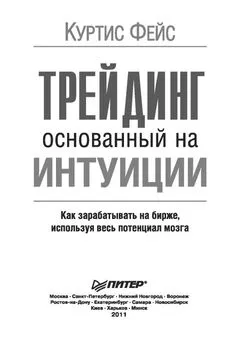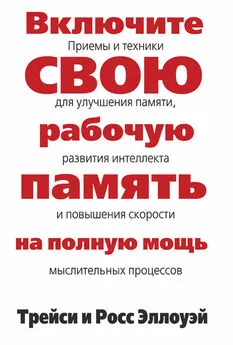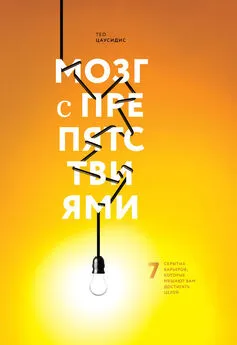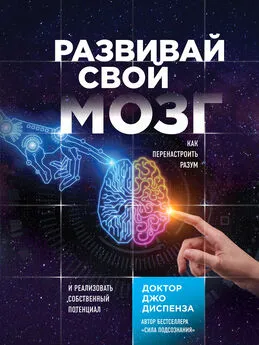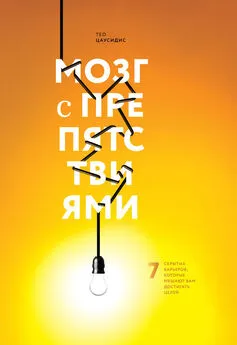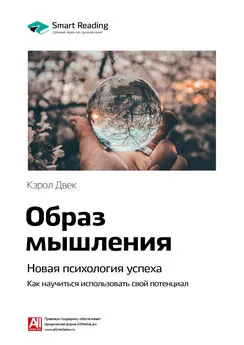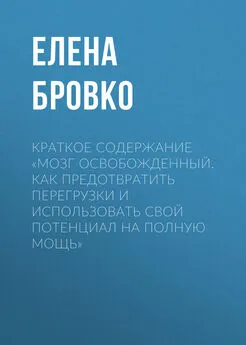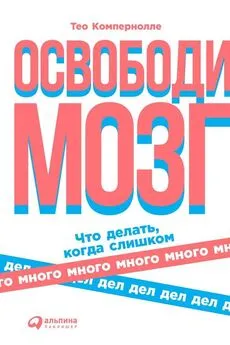Тео Компернолле - Мозг освобожденный. Как предотвратить перегрузки и использовать свой потенциал на полную мощь
- Название:Мозг освобожденный. Как предотвратить перегрузки и использовать свой потенциал на полную мощь
- Автор:
- Жанр:
- Издательство:Array Литагент «Альпина»
- Год:2015
- Город:Москва
- ISBN:978-5-9614-3976-1
- Рейтинг:
- Избранное:Добавить в избранное
-
Отзывы:
-
Ваша оценка:
Тео Компернолле - Мозг освобожденный. Как предотвратить перегрузки и использовать свой потенциал на полную мощь краткое содержание
Мозг освобожденный. Как предотвратить перегрузки и использовать свой потенциал на полную мощь - читать онлайн бесплатно полную версию (весь текст целиком)
Интервал:
Закладка:
379
Toward taming the monster in electronic mail. Demiridjian, Z. S. (2005). The Journal of American Academy of Business, 7, pp. 1–2.
380
“The social economy: Unlocking value and productivity through social technologyproductivity obal Institute, 2012. http://www.mckinsey.com/~/media/McKinsey/dotcom/Insights%20and%20pubs/MGI/Research/Technology%20and%20Innovation/The%20social%20economy/MGI_The_social_economy_Full_report.ashx
381
The cost of e-mail within organizations. Jackson, Thomas W., Ray Dawson and Darren Wilson. Strategies for eCommerce Success (2002): 307.
382
The cost of email within organizations. Jackson, Thomas W., Ray Dawson, and Darren Wilson. Strategies for eCommerce Success (2002): 307.
383
The effects of interruptions on task performance, annoyance, and anxiety in the user interface. Brian P. Bailey, Joseph A. Konstan, John V. Carlis. Proceedings of INTERACT (2001). Volume: 1, Publisher: Citeseer, pp. 593–601.
On the need for attention-aware systems: Measuring effects of interruption on task performance, error rate, and affective state. Brian P. Bailey, Joseph A. Konstan.Computers in Human Behavior Volume 22, Issue 4, July 2006, pp. 685–601.
Reducing the disruptive effects of interruption: A cognitive framework for analysing the costs and benefits of intervention strategies. Deborah A. Boehm-Davis, Roger Remington Accident Analysis & Prevention. Volume 41, Issue 5, Sen 2009, pp. 1124–1129.
384
Understanding e-mail interaction increases organizational productivity. T. Jackson, R. Dawson, D. Wilson. Communications of the ACM, 46 (2003), pp. 80–84. http://dl.acm.org/citation.cfm?id=859673
385
“You’ve Got E-Mail!” … Shall I Deal With It Now? Electronic Mail From The Recipientow? Electronic Mail From The Judith Ramsay, Mario Hair. International Journal Of Humanario Hair Interaction, 21(3), pp. 313–332.
386
E-mail training significantly reduces email defects, International Journal of Information Management, Anthony Burgess, Thomas Jackson, Janet Edwards, Volume 25, Issue 1, Feb 2005, pp. 71–83.
387
Цитируется по “Tipping Sacred Cows” by Jake Breeden, John Wiley & Sons 2013.
388
“A Pace Not Dictated by Electrons’: An Empirical Study of Work without E-Mailirical Study of Work withoutards Armand Cardello. https://students.ics.uci.edu/~svoida/uploads/Publications/Publications/markvoida-chi12.pdf
389
Driving While Distracted. Nationwide. 2008. http://www.nationwide.com/pdf/dwd-2008-survey-results.pdf?NWOSS=survey+2008&NWOSSPos=1 State of the Nation of cell phone distracted driving. http://www.nsc.org/safety_road/Distracted_Driving/Documents/State%20of%20the%20Nation.pdf
www.nhtsa.gov/staticfiles/nti/pdf/811555.pdf
390
Promoting the Car Phone, Despite Risks. By Matt Richtel. New York Times. 6 Dec 2009.
391
Drivers and Legislators Dismiss Cellphone Risks. Matt Richtel. New York Times. 19 July 2009.
392
BlackBerry cuts made roads safer, police say. Awad Mustafa and Caline Malek “The Natoinal” UAE, 15 Oct 2011. http://www.thenational.ae/news/uae-news/blackberry-cuts-made-roads-safer-police-say
393
http://www.nhtsa.gov/Research/Human+Factors/Naturalistic+ driving+studies
394
Reducing Distracted Driving: Regulation and Education to Avert Traffic Injuries and Fatalities. Lawrence O. Gostin. Peter D. Jacobson. 303 JAMA 1419–1420 (2010). http://scholarship.law.georgetown.edu/facpub/380
395
A Comparison of the Cell Phone Driver and the Drunk Driver. David L. Strayer, Frank A. Drews and Dennis J. Crouch. Hum Factors 2006; 48; 381. http://www.psych.utah.edu/abclab/publications/distraction/Strayer(2006)%20-20A%20comparison%20of%20the%20cell-phone%20driver%20and%20the%20drunk%20driver.pdf
Engrossed in conversation: The impact of cell phones on simulated driving performance, Kristen E. Beede, Steven J. Kass, Accident Analysis & Prevention, Volume 38, Issue 2, March 2006, pp. 415–421.
Driver Safety Impacts of Voice-to-Text Mobile Applications. Christine E. Yager. Proceedings of the Human Factors and Ergonomics Society Annual Meeting, Sen 2013, vol. 57, no. 1, pp. 1869–1873.
396
Influence of personal mobile phone ringing and usual intention to answer on driver error, Carol Holland, Versha Rathod, Accident Analysis & Prevention, Volume 50, Jan 2013, pp. 793–800.
397
A Comparison of the Cell Phone Driver and the Drunk Driver. David L. Strayer, Frank A. Drews and Dennis J. Crouch. Hum Factors 2006; 48; 381. http://www.psych.utah.edu/abclab/publications/distraction/Strayer(2006)%20-%20A%20comparison%20of%20the%20cell-phone%20driver%20and%20the%20drunk%20driver.pdf
См. также: Driving whilst using in-vehicle information systems (IVIS): benchmarking the impairment to alcohol. Wynn, T., Richardson, J.H. and Stevens, A., 2013.
Driving whilst using in-vehicle information systems (IVIS): benchmarking the impairment to alcohol. IN: Regan, M.A., Lee, J.D. and Victor, T.W. (eds.) Driver Distraction and Inattention Advances in Research and Countermeasures, Volume 1, pp. 253–275.
398
Passenger and cell phone conversations in simulated driving. Drews, Frank A.; Pasupathi, Monisha; Strayer, David L.
Journal of Experimental Psychology: Applied, Vol. 14(4).
Distracted driving in elderly and middleaged drivers. Kelsey R. Thompson et al. Accident Analysis & Prevention. Volume 45, March 2012, pp. 711–717.
Effects of cellular telephones on driving behaviour and crash risk: Results of meta-analysis. JK Caird, CT Scialfa… – 2004 – psych.ucalgary.ca.
http://www.psych.ucalgary.ca/pace/PCA-Lab/pdf/Final%20Report%20-%20Cell%20Phones.pdf
399
The Effects of Text Messaging During Dual-Task Driving Simulation on Cardiovascular and Respiratory Responses and Reaction Time Creators: Park, Andrew; Salsbury, Joshua; Corbett, Keira; Aiello, Jennifer Issue Date: 2013-01.
The Ohio Journal of Science, v. 111, n 2–5 (Jan 2013), pp. 42–44.
400
http://www.distraction.gov/content/get-the-facts/index.html
Texting while driving: evaluation of glance distributions for Frequent/infrequent texters and keypad/touchpad texters. Siby Samuel, Alexander Pollatsek, & Donald Fisher. Proceedings of the sixth international driving symposium on human factors in driver assessment, training and vehicle design. http://drivingassessment.uiowa.edu/sites/default/files/DA2011/Papers/061_SamuelPollatsek.pdf
VirginiaTech Transportation Institute. New data from VTTI provides insight into cell phone use and driving distraction. 27 July 2009.
Fernando A. Wilson and Jim P. Stimpson. Trends in Fatalities From Distracted Driving in the United States, 1999 to 2008. American Journal of Public Health, ноябрь 2010, Vol. 100, No. 11, pp. 2213–2219.
401
The choice to text and drive in younger drivers: Behavior may shape attitude. Paul Atchley, Stephanie Atwood,Aaron Boulton. Accident Analysis & Prevention. Volume 43, Issue 1, Jan 2011, pp. 134–142.
402
College students’ prevalence and perceptions of text messaging while driving. Marissa A. Harrison. Accident Analysis & Prevention. Volume 43, Issue 4, July 2011, pp. 1516–1520.
403
Adults and Cell Phone Distractions. Madden, M. & Rainie, L., Pew Internet & American Life Project, Pew Research Center (2010). http://pewinternet.org/Reports/2010/Cell-Phone-Distractions.aspx.
The effects of perception of risk and importance of answering and initiating a cellular phone call while driving. Erik Nelson, Paul Atchley, Todd D. Little. Accident Analysis & Prevention. Volume 41, Issue 3, May 2009, pp. 438–444.
404
Effects of car-phone use and aggressive disposition during critical driving maneuvers. Lui, B.-S., Lee, Y.-H., 2005. Transportation Research: Part F 8, pp. 369–382.
Tison, J., Chaudhary, N., & Cosgrove, L. (Dec 2011). National phone survey on distracted driving attitudes and behaviors. (DOT HS 811 555). Washington, DC: National Highway Traffic Safety Administration. www.nhtsa.gov/staticfiles/nti/pdf/811555.pdf
405
Cognitive Distraction While Multitasking in the Automobile. David L. Strayer, Jason M. Watson, and Frank A. Drews, In Brian Ross, editor: The Psychology of Learning and Motivation, Vol. 54, Burlington: Academic Press, 2011, pp. 29–58.
406
Inattentional Blindness in a Simulated Driving Task. Kellie D. Kennedy James P. Bliss Proceedings of the Human Factors and Ergonomics Society Annual Meeting, Sep 2013, vol. 57, no. 1, pp. 1899–1903.
407
Driver distraction: The effects of concurrent in-vehicle tasks, road environment complexity and age on driving performance. Tim Horberry, Janet Anderson, Michael A. Regana, Thomas J. Triggs, John Brown. Accident Analysis & Prevention. Volume 38, Issue 1, Jan 2006, pp. 185–191.
Distraction Effects of In-Vehicle Tasks Requiring Number and Text Entry Using Auto Alliance’s Principle 2.1B Verification Procedure.Thomas A. Ranney ao. National Highway Traffic Safety Administration Vehicle Research and Test Center. http://www.distraction.gov/download/research-pdf/Distraction_Effects_of_In-Vehicle_Tasks_508.pdf
The effects of using a portable music player on simulated driving performance and task-sharing strategies. Original Research Article. Kristie L. Young, Eve Mitsopoulos-Rubens, Christina M. Rudin-Brown, Michael G. Lenne. Applied Ergonomics, Volume 43, Issue 4, July 2012, pp. 738–746.
408
Speech-Based Interaction with In-Vehicle Computers: The Effect of Speech-Based E-Mail on Drivers’ Attention to the Roadway John D. Lee Human Factors: The Journal of the Human Factors and Ergonomics Society, Winter 2001, vol. 43, no. 4, pp. 631–640.
Inattentional Blindness in a Simulated Driving Task. Kellie D. Kennedy James P. Bliss Proceedings of the Human Factors and Ergonomics Society Annual Meeting, Sep 2013 vol. 57, no. 1, pp. 1899–1903.
The Effects of Text Messaging During Dual-Task Driving Simulation on Cardiovascular and Respiratory Responses and Reaction Time Park, Andrew; Salsbury, Joshua; Corbett, Keira; Aiello, Jennifer Issue Date: 2013-01 The Ohio Journal of Science, v.111, n 2–5 (Jan 2013), pp. 42–44.
(only abstract) Driving whilst using in-vehicle information systems (IVIS): benchmarking the impairment to alcohol. Wynn, T., Richardson, J.H. and Stevens, A., 2013. Driving whilst using in-vehicle information systems (IVIS): benchmarking the impairment to alcohol. IN: Regan, M.A., Lee, J.D. and Victor, T.W. (eds.) Driver Distraction and Inattention. Advances in Research and Countermeasures, Volume 1, pp. 253–275.
(only abstract)Texting while driving: is speech-based texting less risky than handheld texting? Proceedings of the 5th International Conference on Automotive User Interfaces and Interactive Vehicular Applications Jibo He and others, 2013, pp. 124–130.
Driver Safety Impacts of Voice-to-Text Mobile Applications. Christine E. Yager. Proceedings of the Human Factors and Ergonomics Society Annual Meeting, сентябрь 2013, vol. 57, no. 1, pp. 1869–1873.
Читать дальшеИнтервал:
Закладка:

